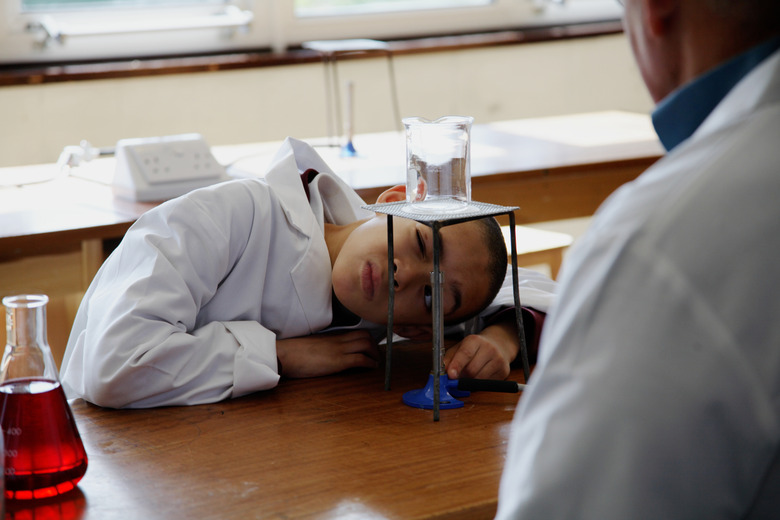Viscosity Science Experiments
Viscosity is the thickness of a liquid or its resistance to flow. Fluids with lower viscosity are referred to as thin liquids and those with higher viscosity as thick liquids. Friction between the molecules in a liquid causes viscosity. Basic viscosity experiments compare the viscosity of different liquids, the shape of the drops of liquids of different thicknesses and the effects of temperature and sugar on viscosity.
Compare Viscosity
Compare Viscosity
Experiments to compare the relative viscosities of different liquids involve timing the fall of an object through a cylinder of the liquid. Use a long, glass cylinder with measurements clearly marked on its side. Place a small wad of cotton or other soft material on the inside at the bottom of the cylinder to protect it. Fill it with water to the top mark and drop a steel ball bearing into the liquid. Time how long the bearing takes to drop to the bottom of the container. Replace the water with liquids of different thicknesses, such as corn syrup or a mixture of glycerin and water, and repeat the experiment. Relate the time taken for the bearing to descend to the thickness or viscosity of the liquid.
Shape of Drops
Shape of Drops
A property related to a liquid's viscosity is the shape of the drops that it forms. The hypothesis is that liquids of higher viscosity form drops with longer "tails" than lower viscosity liquids. Collect a selection of liquids of differing viscosity and put each of them in turn into a pipette. Place a sheet of graph paper behind the pipette and squeeze the pipette bulb so that a drop of liquid emerges. Take a photo of the drop. Compare the photos and relate the shape of the drop to the viscosity of the liquid.
Effect of Temperature
Effect of Temperature
Temperature affects the viscosity of a liquid. Drill a hole in the bottom of a metal measuring cup, cover it and add 1 cup of water at 20 degrees Fahrenheit. Uncover the hole and time how long it takes for the water to empty from the cup. Repeat this with water heated to 30, 40 and 50 degrees Fahrenheit and compare the findings. To extend this experiment, repeat the entire procedure with a different liquid, such as milk or corn syrup.
Adding Sugar
Adding Sugar
You can test liquids to see if the viscosity of a liquid changes with the addition of sugar. Dissolve 1 ounce of sugar into 1 cup of water and pour it into a metal cup with a hole in the bottom. Uncover the hole and record how long it takes for all of the liquid to leave the cup. Repeat this with mixtures of water and 2 ounces, 3 ounces and so on of sugar. Compare the results to find that the sugar increases the viscosity of the water and reduces its rate of flow.
Cite This Article
MLA
Ash, Christina. "Viscosity Science Experiments" sciencing.com, https://www.sciencing.com/viscosity-science-experiments-8493527/. 24 April 2017.
APA
Ash, Christina. (2017, April 24). Viscosity Science Experiments. sciencing.com. Retrieved from https://www.sciencing.com/viscosity-science-experiments-8493527/
Chicago
Ash, Christina. Viscosity Science Experiments last modified August 30, 2022. https://www.sciencing.com/viscosity-science-experiments-8493527/
